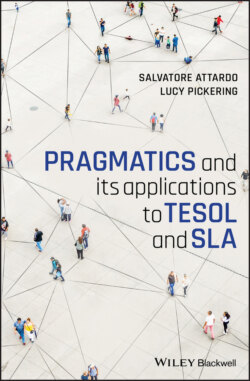Читать книгу Pragmatics and its Applications to TESOL and SLA - Salvatore Attardo - Страница 16
1.1.3 Language in Context
ОглавлениеThus far we have alternated between using the terms “sentence,” “proposition,” and “utterance.” There are deep reasons for doing so. Consider the sentence
(2) I want to eat a donut.
Assume that the speaker is Attardo. We can say that (2) conveys a proposition “Attardo eat a donut.”4 The fact that Attardo wants to eat a donut is the attitude or stance that the speaker has toward the proposition, that is, he wants it to be the case (see Chapter 7 for a more in-depth discussion of stance). However, there is an important missing element: who is the speaker? Where is the exchange taking place? Suppose that the speaker is Attardo who likes donuts very much. Suppose further that the exchange happens in the Sweetie donut store adjacent to the university and Attardo is addressing one of the staff. Under those circumstance, most likely the utterance counts and will be taken as an attempt to purchase a donut. Conversely, if Attardo is standing in the middle of the desert, miles away from the nearest donut shop, it will be read as a hopeless wish. So, the context in which a sentence is uttered is very important in determining what the sentence means. A sentence in context is called an utterance.
The context of an utterance is a very broad construct, which involves who the participants are (Attardo vs. a person on a strict diet), where and when the utterance takes place (the donut shop vs. the desert; opening hours of the shop vs. times it is closed), the activity in which they are involved (purchasing a donut vs. hiking), the culture in which the participants operate (in some cultures, if you are a guest, merely indicating an interest in something is equivalent to requesting it), the beliefs of the participants about the situation (donuts are good) and in general about the world (donuts are still good, but some cultures may not be familiar with them), gestures, facial expressions, and generally speaking behavioral cues (e.g., is Attardo smiling or frowning?), the linguistic and cultural backgrounds of the participants (which may not be the same), and the background knowledge of the participants (which may not coincide).5
In an intercultural exchange, where speakers come from different cultures and different languages, the cultural background and knowledge of the participants will inevitably differ. That is why sometimes there are problems communicating. For example, in the culture where Attardo grew up, offering seconds of food at the table is a way of showing that one cares for one’s guests, and one must politely refuse twice before accepting, or if one refuses a third time, the host assumes that the guest really is full. Pickering, who grew up in a different culture, where food was much less central to the expression of caring, would perceive repeated offerings of seconds to be borderline badgering of guests. Conversely, if someone who shares Attardo’s cultural background is offered food by someone from Pickering’s background, he/she would politely refuse, only to see the plate being withdrawn.
This is why all these components of context, from presuppositions to shared cultural background, are crucial in understanding and negotiating communication. Note that even the understanding of what is happening, of what activity the participants are engaging in, is affected by their cultural backgrounds: when a speaker refuses an offer of seconds, is she being polite or is she full? There is no way of knowing, unless you know what her cultural background is (and even then, she may be accommodating to the different culture in which she is currently operating). The idea of context is much broader than this short discussion allows. See also Section 8.3 for more detail.
Context is also important from another perspective. Traditionally, the assumption has been that semantics deals with meaning per se and that pragmatics deals with meaning in context. While this is a good first approximation, we will see in what follows that the dichotomy cannot be maintained.
